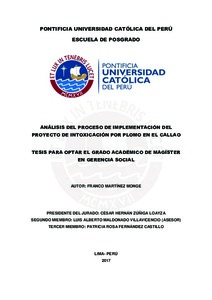| dc.contributor.advisor | Maldonado Villavicencio, Luis Alberto | |
| dc.contributor.author | Martínez Monge, Franco | es_ES |
| dc.date.accessioned | 2019-08-28T16:12:33Z | es_ES |
| dc.date.available | 2019-08-28T16:12:33Z | es_ES |
| dc.date.created | 2017 | es_ES |
| dc.date.issued | 2019-08-28 | es_ES |
| dc.identifier.uri | http://hdl.handle.net/20.500.12404/14831 | |
| dc.description.abstract | Estudios realizados por la Dirección General de Salud Ambiental del Ministerio de
Salud (DIGESA) con el apoyo de la Agencia Internacional de Desarrollo de los Estados
Unidos- USAID arrojaron que los niños del Callao que viven y estudian alrededor de
los depósitos mineros están expuestos a grandes cantidades de plomo en la sangre
que afectan su salud y desarrollo.
Ante dicha realidad, el Gobierno Regional del Callao decide implementar el proyecto
“Control de la Intoxicación por plomo a los alumnos de las Instituciones Educativas
afectadas en el Callao” que pretende reducir los efectos del plomo en la sangre de los
niños con capacitaciones en higiene ambiental y alimentación adecuada con productos
quelantes.
En la actualidad no se cuenta con información que reporte los avances del mismo ni
que analice la eficiencia y eficacia de dicha política. En tal sentido, esta tesis pretende
generar información al respecto y, en particular, de los aciertos y desaciertos en la
implementación del mismo.
Los principales resultados de la investigación realizada sugieren que si bien los
beneficiarios valoran el proyecto y consideran que este habría impactado en la
motivación, la vitalidad y han sensibilizado a los padres sobre la problemática existente
y como abordarla, sin embargo, el proyecto no muestra mejoras en el rendimiento
escolar y buenas practicas nutricionales y medio ambientales en el hogar.
La evidencia generada por esta investigación resulta relevante para el Gobierno
Regional del Callao en la medida que identifica los aciertos y desaciertos en la
implementación del proyecto y pone en evidencia la necesidad de modificarla o
fortalecerla para el logro de los objetivos esperados. Esto resulta especialmente
urgente, en la medida que surgen nuevas denuncias de contaminación por plomo en
otros distritos del Callao, que además de requerir profundizar en la regulación podrían
requerir una intervención de este tipo para minimizar el impacto negativo del tránsito
de minerales por el puerto del Callao. | es_ES |
| dc.description.abstract | Studies conducted by the General Division of Environmental Health of the Ministry of
Health (DIGESA) and the United States Agency for International Development (USAID)
confirm that the children living and studying around mining deposits in Callao have
been exposed lead pollution and observe large amounts of lead in their blood, a
condition that affects both their health and their development opportunities.
In this context, the Regional Government of Callao decided to implement the project
"Control of lead poisoning to students of affected schools in Callao". The objective of
the project is to reduce the effects of lead in children´s blood both with the
environmental hygiene and adequate nutrition.
There is no information that reports the progress of the project not the effectiveness of
such policy. In this sense, this thesis aims to generate information on this regard and,
in particular, the successes and failures in its implementation.
Results suggest that although the beneficiaries value the project and consider that it
has impacted student motivation and vitality and has sensitized parents on the existing
problem and how to approach it, the project does not show improvements on health or
education due to low implementation of good nutritional and environmental practices at
home.
The evidence generated by this research is relevant for the Regional Government of
Callao since it identifies successes and failures in the implementation of the project
and highlights the need to modify or strengthen it to achieve the expected objectives.
This is particularly urgent, as new reports of lead contamination in other districts of
Callao arise, which, in addition to requiring further regulation, may require such
intervention to minimize the negative impact of the transit of minerals through the port
of Callao. | es_ES |
| dc.description.uri | Tesis | es_ES |
| dc.language.iso | spa | es_ES |
| dc.publisher | Pontificia Universidad Católica del Perú | es_ES |
| dc.rights | info:eu-repo/semantics/openAccess | es_ES |
| dc.rights.uri | http://creativecommons.org/licenses/by/2.5/pe/ | * |
| dc.subject | Envenenamiento por plomo en niños | es_ES |
| dc.subject | Envenenamiento por plomo--Perú--Callao (Provincia Constitucional) | es_ES |
| dc.title | Análisis del proceso de implementación del proyecto de intoxicación por plomo en el Callao | es_ES |
| dc.type | info:eu-repo/semantics/masterThesis | es_ES |
| thesis.degree.name | Maestro en Gerencia Social | es_ES |
| thesis.degree.level | Maestría | es_ES |
| thesis.degree.grantor | Pontificia Universidad Católica del Perú. Escuela de Posgrado | es_ES |
| thesis.degree.discipline | Gerencia Social | es_ES |
| renati.discipline | 314127 | es_ES |
| renati.level | https://purl.org/pe-repo/renati/level#maestro | es_ES |
| renati.type | http://purl.org/pe-repo/renati/type#tesis | es_ES |
| dc.publisher.country | PE | es_ES |
| dc.subject.ocde | https://purl.org/pe-repo/ocde/ford#5.09.00 | es_ES |






